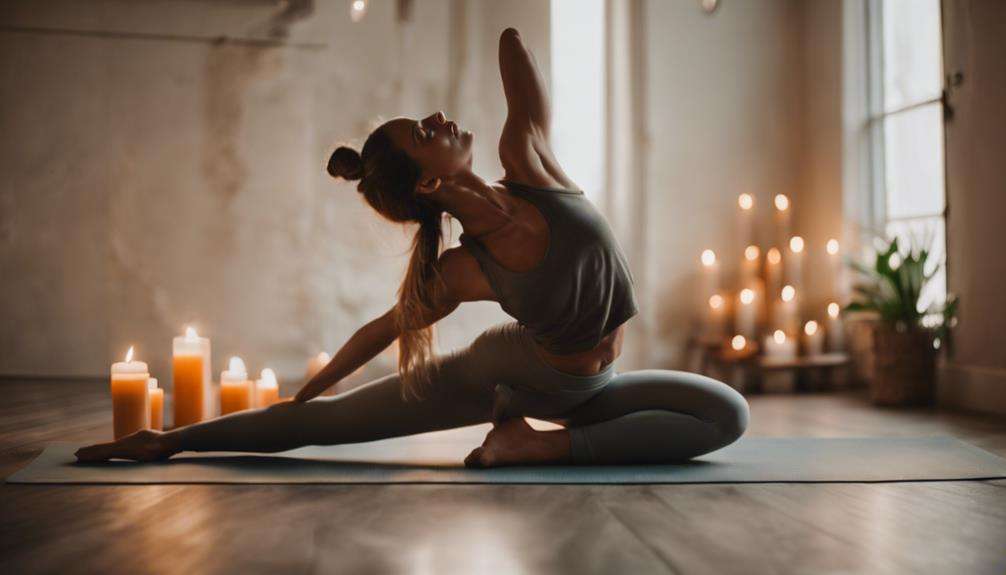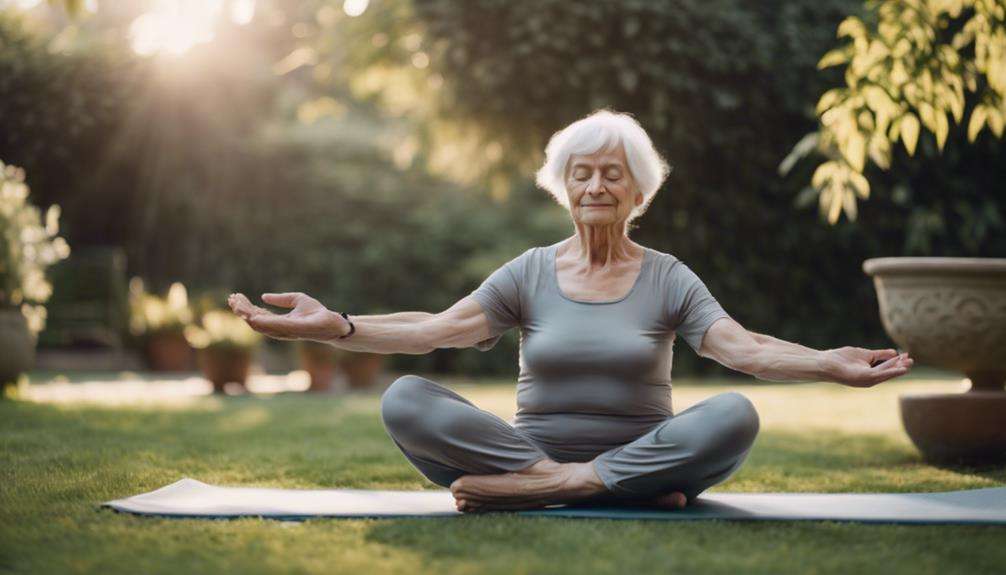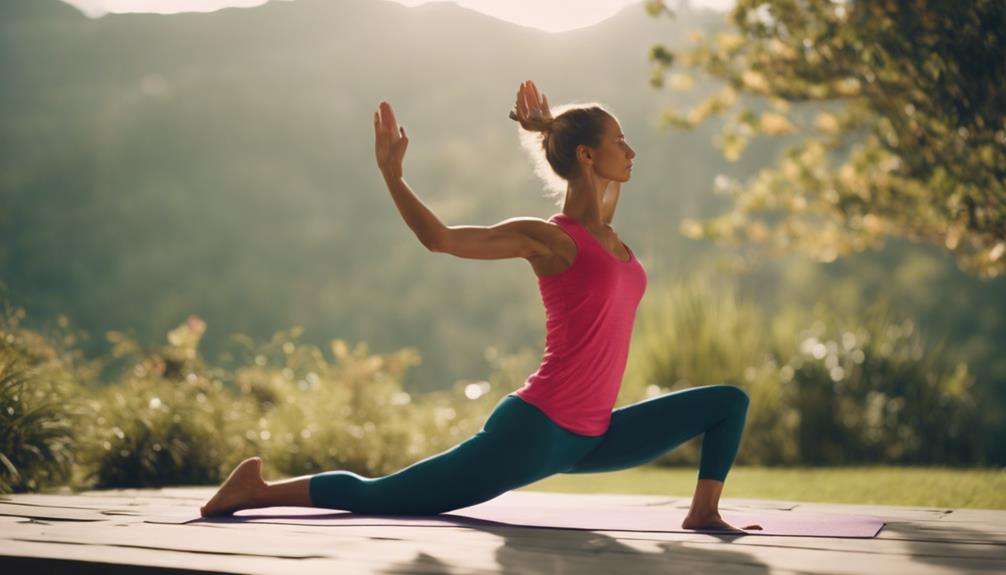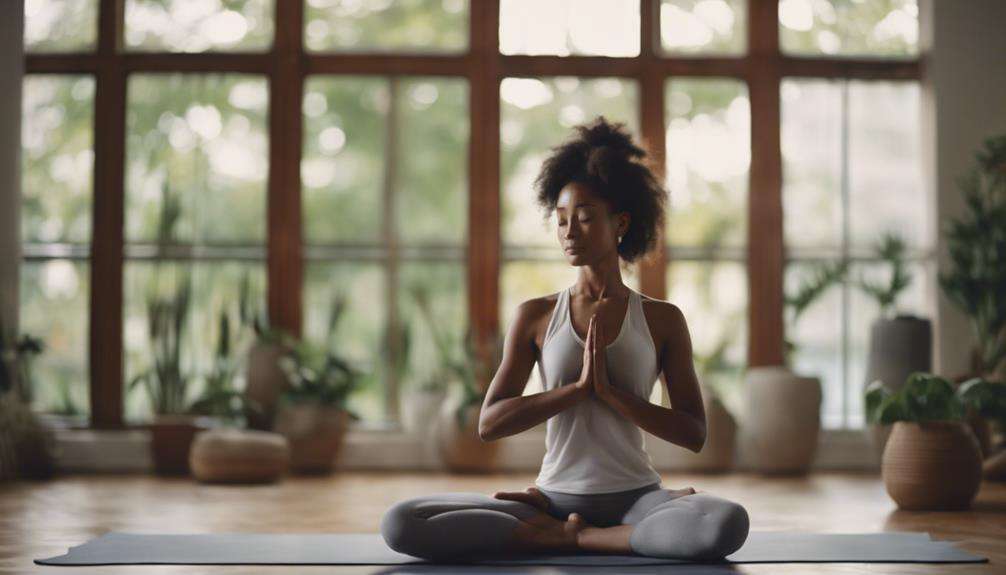When you're struggling with tight hamstrings that limit your range of motion during workouts, have you ever considered how mindful practice could help you achieve greater flexibility and mobility?
By understanding how mindfulness can transform your physical capabilities, you may discover a new approach to unlocking your body's potential.
Let's explore the power of mindfulness in movement and how it can revolutionize your flexibility and mobility beyond what you might have imagined.
Key Takeaways
- Enhance flexibility by deepening body-mind connection through mindful practice
- Improve range of motion by incorporating breathing techniques for muscle relaxation
- Attain better joint mobility and coordination through mindful movement practices
- Target major muscle groups with yoga poses and enhance flexibility with mindful stretching
The Connection Between Flexibility and Mobility
Have you ever wondered about the intricate relationship between flexibility and mobility in optimizing your body's functionality and movement capabilities? Body awareness plays a crucial role in understanding the balance needed between the two. Mobility exercises are key in enhancing joint mobility, stability, and overall movement quality. By incorporating dynamic stretches, joint mobilization techniques, and neuromuscular control exercises, you can reduce the risk of injuries and improve physical performance.
Being mindful of your body's needs and limitations is essential when engaging in mobility training. These exercises not only increase your range of motion but also help in maintaining joint health. By focusing on mobility, you can address any imbalances between flexibility and stability, reducing the risk of joint instability or limited range of motion. Integrating mobility exercises into your fitness routine promotes better movement patterns and prepares your body for various activities, benefiting individuals of all ages and fitness levels.
Stay attuned to your body, practice mobility exercises regularly, and enjoy the improved functionality and reduced risk of injuries that come with it.
Mindful Stretching Techniques for Flexibility
When it comes to enhancing your flexibility through mindful stretching, remember to focus on your breath for deep stretches, visualize your muscles lengthening, and engage in slow, controlled movements.
These techniques can help you improve muscle length, joint health, and overall range of motion.
Breathing for Deep Stretches
To enhance your flexibility and promote relaxation during stretching exercises, incorporate deep breathing techniques for deep stretches.
- Focus on Your Breath: Pay attention to your inhalations and exhalations as you move through each stretch. Deep breathing helps relax your muscles and increases oxygen flow, improving your flexibility.
- Stay Mindful: Engage in mindful breathing techniques to enhance the effectiveness of your stretching routine. Being present in the moment can promote relaxation and focus, allowing you to achieve deeper stretches.
- Release Tension: Incorporate breath awareness into your deep stretches to release any built-up tension in your body. Deep breathing can help reduce stress, improve your posture, and ultimately enhance your overall flexibility.
Visualize Muscle Lengthening
Enhance your flexibility and deepen your stretches by incorporating mindful visualization techniques that focus on muscle lengthening. Visualizing your muscles elongating during stretches can improve overall flexibility by enhancing the mind-body connection.
This practice can also help reduce stress by releasing tension in the body and promoting a sense of relaxation. By focusing on the sensation of muscles stretching, you can improve the quality of your stretches and enhance your range of motion over time.
Mindful movement through visualization techniques not only increases the effectiveness of the stretch but also creates a deeper sense of mindfulness in your stretching practices. Embrace the power of visualization to unlock greater flexibility and mobility in your body.
Slow Controlled Movements
By incorporating slow controlled movements into your mindful stretching routine, you can enhance muscle flexibility and improve joint mobility effectively.
Key Points:
- Enhanced Muscle Flexibility: Slow, deliberate stretches in mindful stretching techniques help increase the elasticity of your muscles, allowing for a greater range of motion.
- Improved Joint Mobility: By focusing on controlled movements, you can target specific joints and work towards enhancing their flexibility and reducing stiffness.
- Mindful Stretching Benefits: Engaging in mindful stretching not only promotes physical benefits like increased flexibility and mobility but also aids in relaxation and mindfulness, creating a holistic approach to wellness.
Practicing mindful stretching techniques with slow, deliberate movements can significantly contribute to your overall well-being by improving muscle flexibility and joint mobility while fostering a deeper mind-body connection.
Meditation Practices for Enhanced Flexibility
Enhancing your flexibility through meditation involves:
- Focusing on your breath
- Strengthening the body-mind connection
- Stretching with heightened awareness
By incorporating these practices into your routine, you can:
- Deepen your flexibility
- Improve joint mobility
- Reduce the risk of injuries
Embracing meditation techniques can lead to:
- A more relaxed state of mind
- Better muscle relaxation
- Increased flexibility in your body
Breathing for Flexibility
To improve your flexibility through mindful practice, incorporating focused breathing techniques is essential for optimizing muscle oxygenation and relaxation. Deep breathing plays a crucial role in enhancing flexibility by ensuring your muscles receive an adequate supply of oxygen, which aids in relaxation and prepares them for stretching exercises.
When practicing controlled breathing techniques during stretches, you increase the oxygen flow to your muscles, assisting in improving flexibility. Mindful breathing practices not only help you stay focused and concentrated during stretching sessions but also contribute to enhancing your overall flexibility.
Remember, proper breathing patterns support muscle relaxation, reduce tension, and promote flexibility effectively.
Key Points:
- Deep breathing optimizes muscle oxygenation for enhanced flexibility.
- Controlled breathing increases oxygen flow during stretching, aiding flexibility.
- Mindful breathing enhances focus and concentration during stretches.
Body-Mind Connection
Improving your flexibility can be greatly enhanced through the practice of mindful meditation, fostering a deeper connection between your body and mind for increased physical awareness and well-being. Mindful practice involves focusing on physical sensations, breath, and movements, which can lead to a heightened understanding of your body's limitations and capabilities.
By incorporating meditation into your stretching routine, you can deepen your stretches, expand your range of motion, and reduce the risk of injuries. Through mindfulness, you create an environment where you can explore your body's physical sensations, release tension, and ultimately improve your overall physical health.
Embracing this body-mind connection in your practice can facilitate a more profound and sustainable enhancement in your flexibility and mobility.
Stretching With Awareness
Mindful stretching combines stretching exercises with awareness and meditation practices, fostering a deeper mind-body connection to enhance flexibility effectively.
When incorporating mindfulness into your stretching routine, consider the following:
- Present Moment Focus: By staying fully present in the moment while stretching, you can heighten your awareness of how your body feels and reacts to each movement, promoting better flexibility gains.
- Mind-Body Connection: Practicing mindfulness during stretching enhances the connection between your mind and body, leading to improved physical and mental well-being overall.
- Stress Reduction: Mindful stretching can help reduce stress, increase relaxation, and encourage better movement patterns, contributing to a more harmonious and flexible body.
Yoga Poses to Improve Flexibility
Enhance your flexibility and mobility with these effective yoga poses targeting major muscle groups. Yoga poses like Downward Dog, Warrior II, and Triangle Pose are excellent for improving flexibility and increasing your range of motion. By regularly practicing these poses, you can enhance joint mobility and muscle flexibility.
Specific poses such as Cobra, Pigeon, and Seated Forward Fold focus on stretching particular areas of the body, contributing to overall flexibility improvement.
Yoga not only benefits your physical body but also promotes mindfulness, body awareness, and relaxation. The variety of poses available allows you to tailor your practice to target different muscle groups, ensuring a comprehensive flexibility workout. By incorporating a diverse range of yoga poses into your routine, you can experience enhanced flexibility, improved mobility, and overall well-being.
Embrace the practice of yoga to unlock your body's full potential and enjoy the benefits of increased flexibility and range of motion.
Mindful Breathing for Flexibility Enhancement
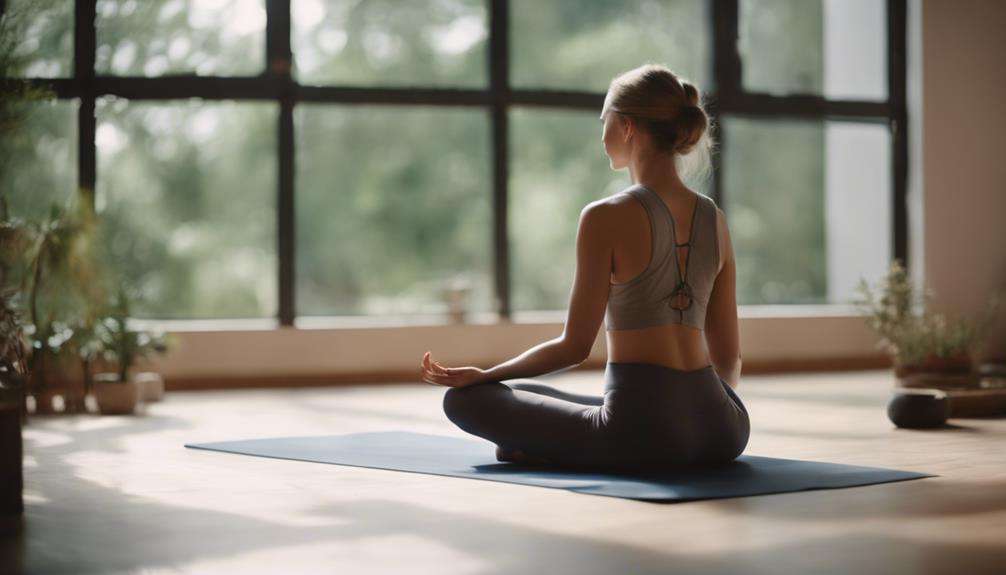
To optimize your flexibility, incorporating mindful breathing techniques into your routine can be highly beneficial. When you focus on your breath, you enhance your body's ability to relax and reduce muscle tension, ultimately aiding in flexibility improvement. Here are three key ways mindful breathing can enhance your flexibility:
- Breath Awareness: By bringing attention to your breath during stretching exercises, you can release tightness in muscles, promoting better range of motion and flexibility.
- Oxygen Flow: Deep breathing techniques increase the oxygen flow to your muscles, which can support flexibility enhancement by providing the necessary nutrients for muscle performance and recovery.
- Mind-Body Connection: When you synchronize your breath with movements, you strengthen the connection between your mind and body. This heightened awareness can lead to improved flexibility as you become more attuned to your body's needs and limits.
Mind-Body Awareness for Increased Flexibility
As you cultivate awareness of your body's sensations and movements, you pave the way for increased flexibility potential. Mind-body awareness plays a crucial role in enhancing flexibility by allowing you to tune into the signals your body sends during movement. By being present in the moment and focusing on how your body moves and feels, you can better understand its capabilities and limitations, ultimately leading to improved flexibility over time.
When you engage in mindful practice, such as paying attention to your breath and bodily sensations, you create a deeper connection with your body. This increased awareness enables you to make subtle adjustments to your movements, gradually expanding your range of motion and flexibility. Through mindful breathing techniques and body awareness exercises, you can tap into your body's innate flexibility and unlock its full potential.
Embracing mind-body awareness as part of your flexibility training can bring about profound changes in how you move and feel. By incorporating these practices into your daily routine, you can experience enhanced flexibility and a greater sense of connection with your body.
Mindful Movement Benefits for Flexibility
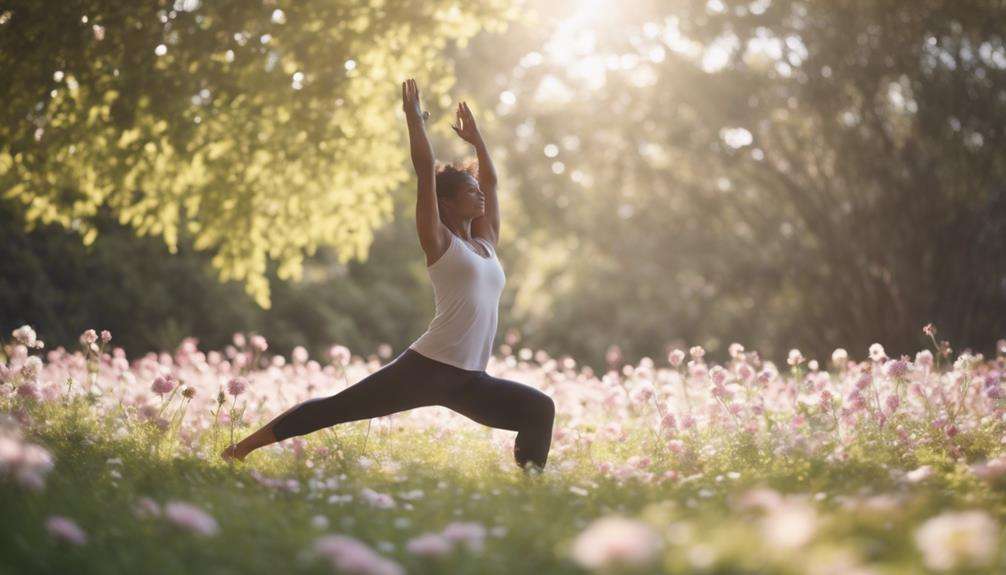
Engage in mindful movement practices to unlock the benefits they offer for enhancing your flexibility and overall well-being. When incorporating mindful movement into your routine, you can experience a range of advantages that contribute to improved flexibility and physical performance while reducing the risk of injury.
- Neuromuscular Control: Mindful movement practices help enhance your neuromuscular control, enabling better coordination between your nervous system and muscles. This improved communication leads to more precise movements, increased range of motion, and better overall flexibility.
- Enhanced Physical Performance: By regularly engaging in mindful movement techniques, you can boost your physical performance. These practices strengthen your muscles, improve balance, and increase endurance, all of which play a vital role in enhancing flexibility and overall athletic abilities.
- Reduced Risk of Injury: Mindful movement not only improves flexibility but also helps lower the risk of injuries by promoting proper body alignment, muscle balance, and joint stability. By fostering body awareness and control, you can mitigate the chances of getting injured during physical activities.
Incorporating Mindfulness Into Stretching
Enhance your stretching routine by incorporating mindfulness to deepen your body awareness and promote a stronger connection with the present moment. Mindful stretching involves focusing your attention on the sensations in your body as you move through each stretch. By practicing mindfulness during stretching, you can cultivate a greater sense of body awareness, allowing you to tune in to areas of tension or tightness that may need extra care.
Incorporating mindful breathing techniques into your stretching routine can further enhance the benefits of this practice. By syncing your breath with your movements, you can improve your focus, promote relaxation, and create a sense of flow in your stretching routine. Mindful breathing helps you stay present in the moment, letting go of distractions and worries, and fully immersing yourself in the experience of stretching.
Mindful Practices for Joint Mobility
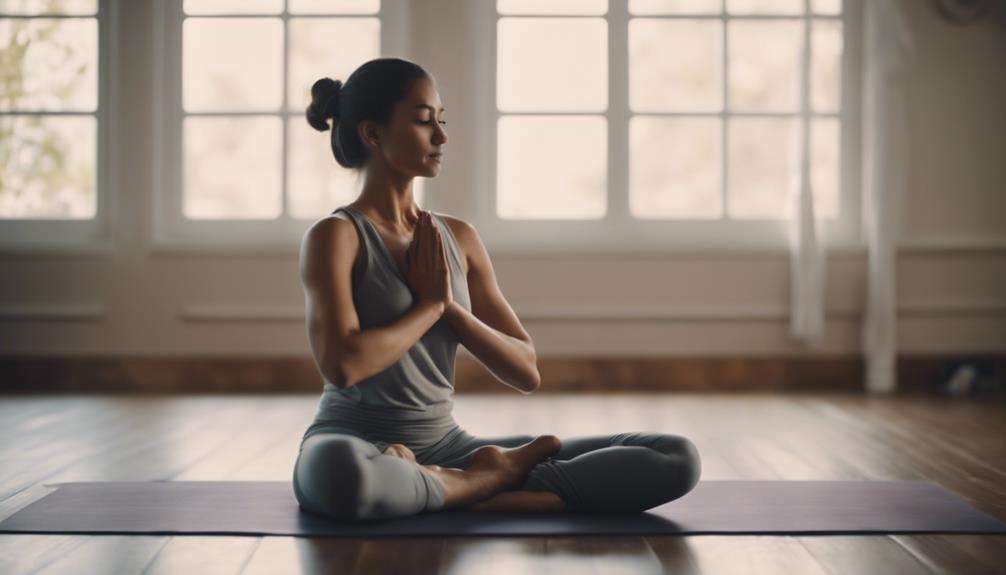
To improve your joint mobility and enhance flexibility, practicing mindful movements and stretches can be incredibly beneficial for your overall well-being and physical health. When you engage in mindful practices for joint mobility, you're actively working towards achieving a full range of motion around your joints. By paying attention to the present moment during these exercises, you allow yourself to connect more deeply with your body and its capabilities.
Here are three key benefits of incorporating mindful practices for joint mobility into your routine:
- Enhanced Flexibility: Mindful joint mobility exercises help you move with greater ease and fluidity, improving your overall flexibility.
- Improved Body Awareness: By focusing on your breath and movement, you enhance your body awareness, leading to better posture and reduced muscle tension.
- Promotion of Relaxation: Mindful practices for joint mobility can help reduce stress in your joints, promoting relaxation and overall physical well-being.
Frequently Asked Questions
How Do You Practice Mindful Movement?
To practice mindful movement, focus on breath awareness, body alignment, and the mind-body connection. Redirect your attention when thoughts drift, fostering a deeper connection. Engage in intentional, present-centered movements to boost focus, energy, and well-being.
What Is Mindful Stretching?
Mindful stretching enhances flexibility benefits by deepening the mind-body connection. Focus on body sensations, breath, and movement to improve posture. Incorporate stretching techniques with mindfulness to increase awareness and improve joint mobility.
What Is a Mindful Form of Exercise?
To connect your mind and body, engage in mindful exercises that enhance body awareness, breathing techniques, and the mind-body connection. Stay present in each movement, embracing the unity of your physical and mental self.
What Is the Mindful Movement?
Mindful movement involves bringing full attention to the present moment through intentional movement, breath awareness, and body sensations. It includes practices like walking meditation, stretching, and yoga, focusing on redirecting attention when the mind wanders.
Conclusion
In conclusion, by incorporating mindful movement practices into your daily routine, you can achieve greater flexibility and mobility. Remember, 'practice makes perfect!'
Stay consistent, stay present, and watch as your body becomes more flexible and mobile with each mindful breath and movement.
Embrace the journey towards a healthier and more mobile body, one mindful step at a time. Your body will thank you for it!


